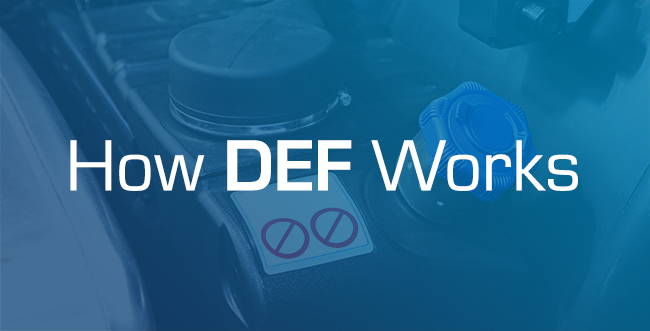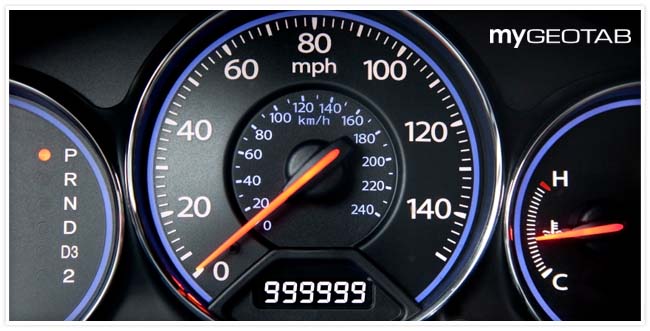Dealing with information overload in telematics (9 strategies)
Too much data and too little time? Here are 9 tips for dealing with information overload.
By Geotab Team
Jan 31, 2018
Updated: Mar 2, 2022

Here’s the problem: You have tons of data and you don’t know what to do with it. Dealing with information overload is a common concern for many managers. This article provides nine tips for coping and making the most of your telematics data.
Do You Have Data Overload?
Also called “drinking from the fire hose,” information overload means you’re taking in more data than you can handle. Being flooded with information is the opposite of being in the dark, but it could be just as dangerous — especially if you’re responsible for driver safety. Negligence is not something your company wants to get caught up in. See: Duty of Care for Fleet Managers.
A common concern we hear at Geotab is, “What do I do with all that data?” and, “How do I organize and understand all my information?”
Telematics solutions like Geotab can offer you loads of data about your vehicles and drivers. Examples include: vehicle position, speed, trip distance/time, idling, harsh braking and aggressive driving, seat belt use, fuel consumption, vehicle faults, battery voltage, and more. Add big data and predictive analytics on top of that, and it can be intimidating to a new user.
See Also: Is Your Fleet Ready for Big Data & Advanced Analytics?
Symptoms of Information Overload
Here are telltale signs that you could be suffering from information overload and not taking advantage of the benefits telematics brings:
- Runaway fuel costs
- Too many costly vehicle collisions
- Unplanned repairs and high maintenance costs
- Poor customer satisfaction level
- Low overall productivity
- Compliance violations
If you’ve had telematics for a while and you’re still experiencing any of these or you’re new to the game and not sure how to approach any of these, then it’s likely you’re suffering from information overload.
The Cost of Ignoring
What you don’t know could be hurting you. Whether it’s a company delaying adoption of telematics even though they need it, or another company with a telematics solution that isn’t using it to the full extent, both are losing out on valuable insights and the related productivity, safety, and financial benefits. These lost cost-savings opportunities are also known as the Cost of Ignoring.
The saying used to be “Time is money” but today it’s “Data is money.” Ultimately, when not taking advantage of data, you’re cutting into profits.
9 Strategies for Coping with Telematics Information Overload
If you haven’t worked with this volume of data before, how do you know where to start?
Read some advice from the Geotab experts on how to manage data overload.

Owen D’Acres, Customer Experience & Support Training Coordinator
- Stop whatever you are doing take a step back and review your goals.
- Think about what is your present priority and what is a critical goal you want to achieve immediately or over a specific time period, and then focus on that.
- Remember we live in an information age, so information is not going anywhere any time soon. Therefore, try to manage your priorities and not the data.
- Finally, use the technology and available tools to search and filter ONLY for the data that you need for a particular task.

Marc Christelis, Production and Quality Manager
Have a clear goal of what you want to get out of the data, even before you look at it. With the wealth of information we have at our fingertips there are many ways to obtain or manipulate all the data we have into various aspects that show different perspectives. The data comes from many different places and is pooled together, but this can be an overwhelming picture to look at.
By dissecting our objectives or goals first, we can narrow down a focal point to reach our end goal. Take a few key points of what you would like to achieve from the dataset and start with small objectives. From these objectives we can also target pulling our data to focal points and get rid of the “noise.”

Jerry Leatherman, Partner Account Manager
Ask yourself: Do you have the bandwidth to procure, analyze and make critical decisions with the large amounts of data available? Geotab provides a decisionmaker with multiple routes to easily extract, decipher and execute a fleet management plan.
I have found that some of the most successful users of a telematics platform are those who simply say: "Just show me what I need to know." That way, the Reseller configure an easy-to-read report that is emailed to them on a regular basis.
Personally, I find great value in a report that combines driver behavior data and idling habits, which can be used to identify high-risk drivers and fuel savings all in one place.

Cary Carter, Partner Account Manager
One of the biggest issues a new user faces when starting out with telematics is data overload, so it’s okay to request a limited amount to start. If too much is being sent to you or produced in front of you and you’re not sure where to start, request less information. Understand that information first and then move on to learn more.
For example: If you are interested in where your vehicles are spending their time in the day, and maybe fuel economy and daily mileage, then start with a report for these three items and only these three. If asked about any other interests, choose to only look at these items for a few weeks to a few months and digest the data. Once you know what is happening in these areas, and you feel comfortable with the information, you can move on to safety data like speeding, seat belts and dangerous driving events.
Starting small allows you to learn each item and not be overwhelmed with everything at once.

Harrison Chen, Web Developer
It’s scary to deal with huge amounts of information. You are probably panicking and don’t know where to start. I usually consider the situation like a giant puzzle.
Starting small and group-filtering is your best strategy. Start small by identifying the one thing you are really interested in, find it, filter it and group it, and then put it aside. Move on to another area of interest. Before you know it, most of your data is all organized.
Keep in mind, most of the systems allow you to save the filters and groupings so that they can be reused. Therefore, you may only need to do this once and you will end up with an organized report and never have to deal with creating groups again.
Marc Christelis, Production and Quality Manager
Break down a large set of data into a small subgroup that you can work with easily. Once you have a way of viewing it, move the methodology to a larger pool or the entire pool. Use filters and pivot tables to play around with different combinations or manipulation techniques.
If you are working with a large sheet of data, take a sample of just 1 cell by 5 cells and try to understand the story it tells. Next try a pivot table with multiple cells and move the data around. You will be amazed at how quickly you can make your large data set relevant — maybe even in a way that doesn't align with your initial goal.

Marc Christelis, Production and Quality Manager
Sanitize the data. Is the information you have accurate and does it make sense? Is the information we are gathering correct? By scrutinizing a sample of the data fields and digging into the details of where the data came from and how it was generated, you will quickly get a sense of whether or not the information is real or if there was an error in the way it was collected or positioned. By sanitizing the information we ensure our end result isn’t providing false, misleading information.

Kyle Dodsworth, ELD Specialist
If you find the wealth of information hard to use in your daily business, try using groups to silo your data into related business areas and view your data by groups instead of all at once.
You can also try using emailed reports to send summaries of your data to your email on a predetermined frequency — leaving you free to look for outliers in your data that need attention.
In addition to other regular reports, you can try using the Send Report feature in MyGeotab. Send report allows you to set up an emailed report that gets triggered when there is new data related to your specified focus. For example, if your report counts harsh braking exceptions, you would only receive an email if new harsh braking events were captured. This way you only get notified about important events, and won’t receive emailed reports with no events listed.
Jordan Guter, Manager, Solutions Engineering
By using Geotab reports, users can separate the data into a format that is easier to comprehend, allowing for further analysis into areas important to their fleet.
See Also: The Power of Custom Fleet Management Reporting

James McCudden, Solutions Specialist
MyGeotab exception rule reporting can take a large stream of data and turn it into actionable dashboard reports. Individual drivers can understand their performance, and managers have the ability to measure driver behavior.
Ben Pawlowski, Sr. Learning Center Trainer
Geotab is customizable in the sense that users have full control over how much or how little data they want to receive, ranging from real-time alerts to scheduled monthly reports.
Learn about driver scorecards which summarize driving behavior and fleet performance.

Vito Centofanti, Vice President, Sales
Data is not just an influx of large volumes of data. Big data also involves an organization’s ability to use computers and staff to analyze the data and draw conclusions. At Geotab, we draw on the largest vehicle datasets in the industry. Not only can we provide you with copious amounts of your own data, but we will also be able to send you datasets for similar features such as geography, vehicle type, industry type by vehicle, etc.
If the thought of big data is overwhelming right now, choosing a telematics provider that can offer help with data analysis is one way to keep your options open in the future.
Hiring a fleet data analyst or data specialist within your organization will allow you to explore even more options for using your data.
Summary
How to Handle Information Overload:
- Take a step back.
- Establish a clear goal.
- Set realistic expectations.
- Start small.
- Get organized.
- Tidy up.
- Automate your reports.
- Take advantage of dashboards.
- Seek help from your partners.
Conclusion
By working with a long-time industry veteran like Geotab, you’re partnering with a company that holds a wealth of knowledge on best practices so that you can get your return on investment and improve your fleet operations. When it comes to challenges like information overload and taking the mindset of “data is money,” our experts are here to help you cope with these hurdles, allowing you to move straight to the benefits.
For more fleet management tips and news, subscribe to the Geotab newsletter.
Related Posts:
Plausible Deniability vs. Telematics
Do You Have a Big Data Graveyard?
Subscribe to get industry tips and insights
The Geotab Team write about company news.
Table of Contents
Subscribe to get industry tips and insights
Related posts

What is DEF? How diesel exhaust fluid works and why it's essential for fleets
July 16, 2025
5 minute read

Odometer reading: How to check + optimize for smarter fleet management
July 15, 2025
5 minute read

9 strategies to increase fleet fuel efficiency and lower fuel costs
July 8, 2025
4 minute read

Creating a fleet safety culture that’s built to last: Lessons from Missouri DOT and NYC
July 7, 2025
8 minute read

Field service is losing money to bad data: Go beyond GPS with smarter telematics
June 27, 2025
3 minute read
